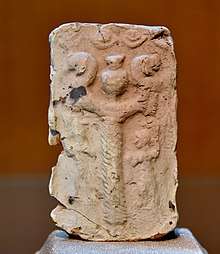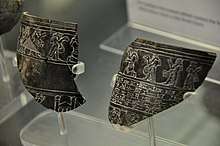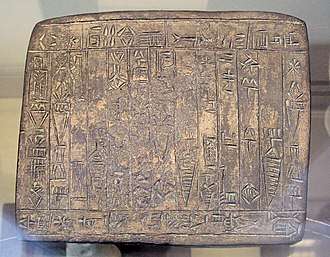Nergal
Nergal, Nirgal, or Nirgali (Sumerian: dKIŠ.UNU[2] or dGÌR-UNUG-GAL𒀭𒄊𒀕𒃲;[3] Hebrew: נֵרְגַל, Modern: Nergal, Tiberian: Nērḡál; Aramaic ܢܹܪܓܵܐܠ; Latin: Nergel) is a deity that was worshipped throughout ancient Mesopotamia (Akkad, Assyria, and Babylonia) with the main seat of his worship at Cuthah represented by the mound of Tell-Ibrahim. Other names for him are Erra and Irra.
| Nergal | |
|---|---|
 | |
| Abode | Kur or Irkalla |
| Planet | Mars |
| Personal information | |
| Parents | Enlil and Ninlil |
| Siblings | Nanna and Ninurta |
| Consort | Ereshkigal (according to some myths) |
| Part of a series on |
| Ancient Mesopotamian religion |
|---|
 Chaos Monster and Sun God |
|
Primordial beings
|
|
Seven gods who decree
|
|
Demigods and heroes
|
|
Spirits and monsters
|
|
Tales
|
| Related topics |
|
Nergal is mentioned in the Hebrew Bible as the deity of the city of Cuth (Cuthah): "And the men of Babylon made Succoth-benoth, and the men of Cuth made Nergal" (2 Kings, 17:30). According to the Talmudists, his emblem was a cockerel[4] and Nergal means a "dunghill cock",[5] although standard iconography pictured Nergal as a lion. He is a son of Enlil and Ninlil, along with Nanna and Ninurta.
Attributes


Nergal seems to be in part a solar deity, sometimes identified with Shamash, but only representative of a certain phase of the sun. Portrayed in hymns and myths as a god of war and pestilence, Nergal seems to represent the sun of noontime and of the summer solstice that brings destruction, high summer being the dead season in the Mesopotamian annual cycle. He has also been called "the king of sunset".[6] Over time Nergal developed from a war god to a god of the underworld.[7] In the mythology, this occurred when Enlil and Ninlil gave him the underworld.[6]
Nergal was also the deity who presides over the netherworld, and who stands at the head of the special pantheon assigned to the government of the dead (supposed to be gathered in a large cave known as Aralu or Irkalla). In this capacity he has associated with him a goddess Allatu or Ereshkigal, though at one time Allatu may have functioned as the sole mistress of Aralu, ruling in her own person. In some texts the god Ninazu is the son of Nergal and Allatu/Ereshkigal.
Ordinarily Nergal pairs with his consort Laz. Standard iconography pictured Nergal as a lion, and boundary-stone monuments symbolise him with a mace surmounted by the head of a lion.
Nergal's fiery aspect appears in names or epithets such as Lugalgira, Lugal-banda (Nergal as the fighting-cock),[8] Sharrapu ("the burner", a reference to his manner of dealing with outdated teachings),[9] Erra, Gibil (though this name more properly belongs to Nusku), and Sibitti or Seven.[10] A certain confusion exists in cuneiform literature between Ninurta (slayer of Asag and wielder of Sharur, an enchanted mace) and Nergal. Nergal has epithets such as the "raging king", the "furious one", and the like. A play upon his name—separated into three elements as Ne-uru-gal (light of the great Ûru;[11] lord of the great dwelling)—expresses his position at the head of the nether-world pantheon.
In the late Babylonian astral-theological system Nergal is related to the planet Mars. As a fiery god of destruction and war, Nergal doubtless seemed an appropriate choice for the red planet, and he was equated by the Greeks to the war-god Ares (Latin Mars)—hence the current name of the planet. In Assyro-Babylonian ecclesiastical art the great lion-headed colossi serving as guardians to the temples and palaces seem to symbolise Nergal, just as the bull-headed colossi probably typify Ninurta.
Nergal's chief temple at Cuthah bore the name Meslam, from which the god receives the designation of Meslamtaeda or Meslamtaea, "the one that rises up from Meslam". The name Meslamtaeda/Meslamtaea indeed is found as early as the list of gods from Fara while the name Nergal only begins to appear in the Akkadian period. Amongst the Hurrians and later Hittites Nergal was known as Aplu, a name derived from the Akkadian Apal Enlil, (Apal being the construct state of Aplu) meaning "the son of Enlil". As god of the plague, he was invoked during the "plague years" during the reign of the Hittite king Suppiluliuma, when this disease spread from Egypt.
The worship of Nergal does not appear to have spread as widely as that of Ninurta, but in the late Babylonian and early Persian period, syncretism seems to have fused the two divinities, which were invoked together as if they were identical. Hymns and votive and other inscriptions of Babylonian and Assyrian rulers frequently invoke him, but we do not learn of many temples to him outside of Cuthah. The Assyrian king Sennacherib speaks of one at Tarbisu to the north of the Assyrian capital of Nineveh, but significantly, although Nebuchadnezzar II (606–586 BC), the great temple-builder of the neo-Babylonian monarchy, alludes to his operations at Meslam in Cuthah, he makes no mention of a sanctuary to Nergal in Babylon. Local associations with his original seat—Kutha—and the conception formed of him as a god of the dead acted in making him feared rather than actively worshipped.
Myths
The Wrath of Erra
In this myth, Nergal is feeling dull and bored. To wake himself up, he decided to attack Babylon. However, Babylon is under the protection of Marduk, the most powerful of the gods. Nergal travels to Babylon on the ruse of a friendly visit. Pretending to show shock at the appearance of Marduk's clothing, he convinces the god to get a change of clothing and leave the city. Once Marduk has left Babylon, Irra attacks the city. People are slain in the streets. Soon Irra is satisfied and stops the attack and makes a prophecy about a great leader to protect the people.[12]
Nergal and Ereshkigal
According to this myth, the gods have created a banquet for which all deities are invited. However, Ereshkigal is unable to leave the underworld. Instead, she sends her son Namtar to take a share of the feast. When Namtar arrives, the other deities rise out of respect except for Erra. Insulted, Namtar goes home and tells his mother. Enki and other gods tell Nergal to enter the underworld. Nergal takes with him 14 demons. When he arrives, the gatekeeper Neti gets orders from Ereshkigal to allow him through the seven gates, stripping him of everything until the throne room, where he would be killed. But at each gate, Nergal posts two demons. When he gets to the throne he knocks over Namtar and drags Ereshkigal to the floor. He is about to kill her with his ax when she pleads for her life, promising her as his wife and to share her power with him. He consents. However, Nergal must still leave the underworld for six months, so Ereshkigal gives him back his demons and allows him to traverse the upper world for that time, after which he returns to her. This myth shows how war is fought in seasons.[12]
Cult places

"Of Nergal the lord of Hawalum, Atal-shen, the caring shepherd, the king of Urkesh and Nawar, the son of Sadar-mat the king, is the builder of the temple of Nergal, the one who overcomes opposition. Let Shamash and Ishtar destroy the seeds of whoever removes this tablet. Shaum-shen is the craftsman."[13]
The main cult centre of Nergal was Kutha, and also enjoyed patronage over Mashkan-shapir. Cults are also attested for Dilbat, Isin, Larsa, Nippur, Ur and Uruk.[14]
Time periods attested
Earliest evidence on Nergal is as the god Meslamtaea in Kutha, in god-lists from Fara and Abu Salabikh. The name Nergal first appears in the Ur III period (22nd to 21st century BC). In the second millennium, Nergal comes to co-rule the underworld with Ereškigal. In the Neo-Assyrian period, he is attested as a significant figure in official Assyrian religious veneration.[14]
In demonology
Because he was a god of fire, the desert, and the Underworld and also a god from ancient paganism, later Christian writers sometimes identified Nergal as a demon and even identified him with Satan. According to Collin de Plancy and Johann Weyer, Nergal was depicted as the chief of Hell's "secret police", and worked as "an honorary spy in the service of Beelzebub".[15]
In popular culture
Nergal has been rendered into Nurgle, the Chaos god of pestilence, decay and in sharp contrast to that, he is also the god of rebirth, in the Games Workshop Warhammer gaming universe. Nurgle is the only Chaos deity which has connections in the real world deities.
He is a recurring character in The Grim Adventures of Billy and Mandy, having married Billy's aunt and eventually siring a son, Nergal Jr, who also becomes a recurring character.
In the video game Catherine, Nergal is the father of the titular succubus.
In the DC/Vertigo comic book series Hellblazer Nergal, the Babylonian god turned demon, is one of John Constantine's most dangerous and persistent foes. [16] [17] [18]
In the Image Comics series The Wicked + The Divine, Baphomet reveals himself to be the incarnation of Nergal, rather than of Baphomet [19].
See also
References
- Drijvers, H. J. W. (1980). Cults and Beliefs at Edessa. Leiden, The Netherlands: E. J. Brill. p. 105. ISBN 90-04-06050-2.CS1 maint: ref=harv (link)
- Wiggermann, Frans. "Nergal B.". Reallexikon der Assyriologie und Vorderasiatischen Archäologie. Walter de Gruyter.
- Borger R. (2004), Mesopotamisches Zeichenlexikon, Münster, p.402
- "2 Kings 17:30". Clarke's Commentary on the Bible. biblecommenter.com.
- Ebenezer Cobham Brewer (1900)."Cock and Bull story". Dictionary of phrase and fable: giving the derivation, source, or origin of common phrases, allusions, and words that have a tale to tell. p. 268.
- Zolyomi, Gabor (2010). "Hymns to Ninisina and Nergal on the Tablets Ash 1911.235 and Ni 9672" in Your Praise Is Sweet: A Memorial Volume for Jeremy Black from Students, Colleagues, and Friends. London: British Institute for the Study of Iraq. pp. 413–428.
- Munnich, Maciej M. (2013). The God Resheph in the Ancient Near East. Tubingen, Germany: Mohr Siebeck. pp. 62–63.
- Encyclopædia of Religion and Ethics, Volume 6 – edited by James Hastings, John Alexander Selbie, Louis Herbert Gray – p.645
- Ford, Michael (18 August 2018). Maskim Hul: Babylonian Magick. Lulu.com. ISBN 9781435763340 – via Google Books.
- David's Secret Demons: Messiah, Murderer, Traitor, King by Baruch Halpern – p.334 Reference 1
- Clay, Albert T. (1 March 2014). Amurru: The Home of the Northern Semites. Wipf and Stock Publishers. ISBN 9781625647115 – via Google Books.
- "Nergal". Ancient History Encyclopedia. Retrieved 2018-04-15.
- "Royal inscriptions". urkesh.org.
- "Nergal (god)". oracc.museum.upenn.edu.
- "Maunal 2 on the Occult" – via Internet Archive.
- Hellblazer #6
- Hellblazer #9
- Hellblazer #11-12
- The Wicked + The Divine #38

External links

- ETCSL "A hymn to Nergal" and "A tigi to Nergal": Unicode and ASCII
- Ereskigal.net – "Ereshkigal and Nergal": Assyrian version and Amarna version
- Gateway to Babylon: Nergal and Ereshkigal
_-_EnKi_(Sumerian).jpg)